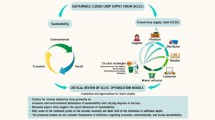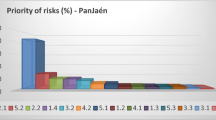Abstract
Supply chain (SC) design problems are often characterized with uncertainty related to the decision-making parameters. The stochastic goal programming (SGP) was one of the aggregating procedures proposed to solve the SC problems. However, the SGP does not integrate explicitly the Manager’s preferences. The aim of this paper is to utilize the chance constrained programming and the satisfaction function concept to formulate strategic and tactical decisions within the SC while demand, supply and total cost are random variables.



Similar content being viewed by others
References
Aköz, O., & Petrovic, D. (2007). A fuzzy goal programming method with imprecise goal hierarchy. European Journal of Operational Research, 181(3), 1427–1433.
Aouni, B., & Kettani, O. (2001). Goal programming model: A glorious history and promising future. European Journal of Operational Research, 133(2), 38–46.
Aouni, B., Abdelaziz, F. B., & Martel, J. M. (2005). Decision-maker’s preferences modeling in the stochastic goal programming. European Journal of Operational Research, 162(3), 610–618.
Azadeh, A., Ghaderi, S. F., Dehghanbaghi, M., & Dabbaghi, A. (2010). Integration of simulation, design of experiment and goal programming for minimization of make span and tardiness. The International Journal of Advanced Manufacturing Technology, 46(5–8), 431–444.
Azaron, A., Furmans, K., & Modarres, M. (2010). Multi-objective stochastic programming approaches for supply chain management. In New developments in multiple objective and goal programming, (pp. 1–14). Berlin: Springer.
Ben Abdelaziz, F., & Sameh, M. (2001). Application of goal programming in a multi-objective reservoir operation model in Tunisia. European Journal of Operational Research, 133(2), 352–361.
Bhattacharya, U. K. (2009). A chance constraints goal programming model for the advertising planning problem. European Journal of Operational Research, 192(2), 382–395.
Bravo, M., & Gonzalez, I. (2009). Applying stochastic goal programming: A case study on water use planning. European Journal of Operational Research, 196(3), 1123–1129.
Charnes, A., & Cooper, W. W. (1952). Chance conctraints and normal deviates. Journal of American Statistics Association, 57, 134–148.
Charnes, A., & Cooper, W. W. (1959). Chance-constrained programming. Management Sciences, 6, 73–78.
Charnes, A., & Cooper, W. W. (1963). Deterministic equivalents for optimizing and satisfying under chance constraints. Operations Research, 11, 18–39.
Charnes, A., Cooper, W. W., & Ferguson, R. (1955). Optimal estimation of executive compensation by linear programming. Management Sciences, 1, 138–351.
Cherif, M. S., Chabchoub, H., & Aouni, B. (2008). Quality control system design through the goal programming model and the satisfaction functions. European Journal of Operational Research, 186, 1084–1098.
Chopra, S., & Meindl, P. (2001). Supply chain management: Strategy, planning and operation. ISBN 0-13-026465-2, pp. 1–7.
Contini, B. (1968). A stochastic approach to goal programming. Operations Research, 16(3), 576–586.
Forza, C., Salvador, F., & Rungtusanatham, M. (2005). Coordinating product design, process design, and supply chain design decisions: Part B. Coordinating approaches, tradeoffs, and future research directions. Journal of Operations Management, 23(3–4), 319–324.
Ho, W., Lee, C. K. M., & Ho, G. T. S. (2008). Optimization of the facility location-allocation problem in a customer-driven supply chain. Operations Management Research, 1(1), 69–79.
Hung, S. J. (2011). Activity-based divergent supply chain planning for competitive advantage in the risky global environment: A DEMATEL-ANP fuzzy goal programming approach. Expert Systems with Applications, 38(8), 9053–9062.
Ignizio, J. P. (1982). On the (re)discovery of fuzzy goal programming. Decision Sciences, 13, 331–336.
Jolai, F., Razmi, J., & Rostami, N. K. M. (2011). A fuzzy goal programming and meta heuristic algorithms for solving integrated production: Distribution planning problem. Central European Journal of Operations Research, 19(4), 547–569.
Jung, H. (2011). A fuzzy AHP–GP approach for integrated production-planning considering manufacturing partners. Expert Systems with Applications, 38(5), 5833–5840.
Ku, C. Y., Chang, C. T., & Ho, H. P. (2010). Global supplier selection using fuzzy analytic hierarchy process and fuzzy goal programming. Quality and Quantity, 44(4), 623–640.
Kumar, M., Vrat, P., & Shankar, R. (2004). A fuzzy goal programming approach for vendor selection in supply chain. Computers & Industrial Engineering, 46(1), 69–85.
Lee, A. H., Kang, H. Y., & Chang, C. T. (2009). Fuzzy multiple goal programming applied to TFT-LCD supplier selection by downstream manufacturers. Expert Systems with Applications, 36(3), 6318–6325.
Leung, S. C. H., & Ng, Wan-lung. (2007). A goal programming model for production planning of perishable products with postponement. Computers & Industrial Engineering, 53(3), 531–541.
Leung, S. C. H., & Chan, S. S. W. (2009). A goal programming model for aggregate production planning with resource utilization constraint. Computers & Industrial Engineering, 56(3), 1053–1064.
Li, L., Fonseca, D. J., & Chen, Der-San. (2006). Earliness-tardiness production planning for just-in-time manufacturing: A unifying approach by goal programming. European Journal of Operational Research, 175(1), 508–515.
Liang, T. F. (2009). Fuzzy multi-objective project management decisions using two-phase fuzzy goal programming approach. Computers & Industrial Engineering, 57(4), 1407–1416.
Liao, C. N., & Kao, H. P. (2011). An integrated fuzzy TOPSIS and MCGP approach to supplier selection in supply chain management. Expert Systems with Applications, 38(9), 10803–10811.
Liu, B. (1996). Dependent-chance goal programming and its genetic algorithm based approach. Mathematical and Computer Modeling, 24(7), 43–52.
Lotfi, M. M., & Torabi, S. A. (2011). A fuzzy goal programming approach for mid-term assortment planning in supermarkets. European Journal of Operational Research, 213(2), 430–441.
Martel, J. M., & Aouni, B. (1990). Incorporating the decision-maker’s preferences in the goal programming model. Journal of Operational Research Society, 41(1), 1121–1132.
Martel, J. M., & Aouni, B. (1996). Incorporating the decision-maker’s preferences in the goal programming model with fuzzy goals values, a new formulation lecture notes in economics and mathematical systems. Berlin: Springer.
Martel, J. M., & Aouni, B. (1998). Diverse imprecise goal programming model formulations. Journal of Global Optimization, 12, 127–138.
Min, H., & Melachrinoudis, E. (1996). Dynamic location and entry mode selection of multinational manufacturing facilities under uncertainty: A chance-constrained goal programming approach. International Transactions in Operational Research, 3(1), 65–76.
Mula, J., Peidro, D., Diaz-Madronero, M., & Vicens, E. (2009). Mathematical programming models for supply chain production and transport planning. European Journal of Operational Research, 204, 377–390.
Özcan, U., & Toklu, B. (2009). Multiple-criteria decision-making in two-sided assembly line balancing: A goal programming and a fuzzy goal programming models. Computers & Operations Research, 36(6), 1955–1965.
Rostami NKi, M., Razmi, J., & Jolai, F. (2010). Designing a genetic algorithm to solve an integrated model in supply chain management using fuzzy goal programming approach. Balanced Automation Systems for Future Manufacturing Networks, 168–176.
Sabri, E. H., & Beamon, B. M. (2000). A multi-objective approach to simultaneous strategic and operational planning in supply chain design. Omega, 28, 581–598.
Santoso, T., Ahmed, S., Goetschalckx, M., & Shapiro, A. (2005). A stochastic programming approach for supply chain network design under uncertainty. European Journal of Operational research, 167, 96–115.
Selim, H., & Ozkarahan, I. (2008). A supply chain distribution network design model: An interactive fuzzy goal programming-based solution approach. The International Journal of Advanced Manufacturing Technology, 36(3–4), 401–418.
Selim, H., Araz, C., & Ozkarahan, I. (2008). Collaborative production-distribution planning in supply chain: A fuzzy goal programming approach. Transportation Research Part E: Logistics and Transportation Review, 44(3), 396–419.
Sinha, S. B., Rao, K. A., & Mangaraj, B. K. (1988). Fuzzy goal programming in multi-criteria decision systems: A case study in agriculture planning. Socio-Economic Planning Sciences, 22(2), 93–101.
Stevens, G. C. (1989). Integrating the supply chains. International Journal of Physical Distribution and Materials Management, 8(8), 3–8.
Syntetos, A. A., Babai, M. Z., Lengu, D., & Altay, N. (2011). Distributional assumptions for parametric forecasting of intermittent demand, in service parts management. London: Springer.
Taylor, B. W., & Anderson, P. F. (1979). Goal programming approach to marketing/ production planning. Industrial Marketing Management, 8(2), 136–144.
Wang, G., Huang, S. H., & Dismukes, J. P. (2005). Manufacturing supply chain design and evaluation. The International Journal of Advanced Manufacturing Technology, 25(1–2), 93–100.
Wong, J. T. (2012). DSS for 3PL provider selection in global supply chain: Combining the multi-objective optimization model with experts’ opinions. Journal of Intelligent Manufacturing, 23(3), 599–614.
Yang, L., & Feng, Y. (2007). A bicriteria solid transportation problem with fixed charge under stochastic environment. Applied Mathematical Modeling, 31(12), 2668–2683.
Zarandi, M. H. F., Sisakht, A. H., & Davari, S. (2011). Design of a closed-loop supply chain (CLSC) model using an interactive fuzzy goal programming. The International Journal of Advanced Manufacturing Technology, 56(5–8), 809–821.
Zhou, S. Y., & Chen, R. Q. (2001). A decision model for selecting participants in supply chain. Journal of Shanghai University (English Edition), 5(4), 341–344.
Author information
Authors and Affiliations
Corresponding author
Rights and permissions
About this article
Cite this article
Azimian, A., Aouni, B. Supply chain management through the stochastic goal programming model. Ann Oper Res 251, 351–365 (2017). https://doi.org/10.1007/s10479-015-2007-1
Published:
Issue Date:
DOI: https://doi.org/10.1007/s10479-015-2007-1




